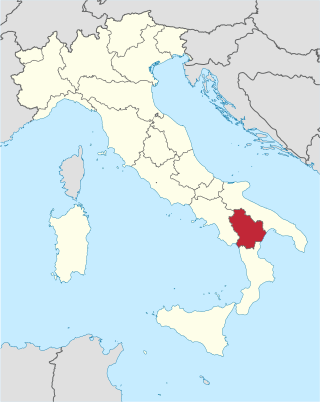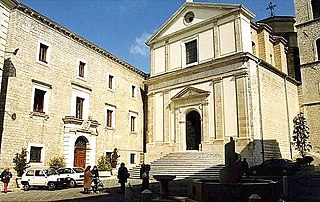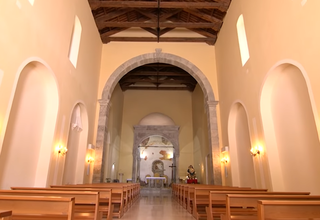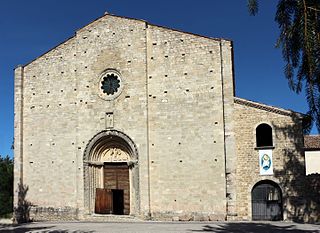
Matera is a city and the capital of the Province of Matera in the region of Basilicata, in Southern Italy. With a history of continuous occupation dating back to the Palaeolithic, it is renowned for its rock-cut urban core, whose twin cliffside zones are known collectively as the Sassi.

Basilicata, also known by its ancient name Lucania, is an administrative region in Southern Italy, bordering on Campania to the west, Apulia to the north and east, and Calabria to the south. It has two coastlines: a 30-km stretch on the Tyrrhenian Sea between Campania and Calabria, and a longer coastline along the Gulf of Taranto between Calabria and Apulia. The region can be thought of as the "instep" of the "boot" of Italy, with Calabria functioning as the "toe" and Apulia the "heel".

Marsico Nuovo is a town and comune of the province of Potenza in the Basilicata region of southern Italy. It was the seat of the bishops of Grumentum.

Montescaglioso is a town and comune in the Province of Matera, Basilicata, southern Italy.

Calvello is a town and comune in the province of Potenza, in the Southern Italian region of Basilicata, known for its traditional production of artistic ceramics. It is bounded by the towns of Abriola, Anzi, Laurenzana, Marsico Nuovo, Marsicovetere, Viggiano.

Tursi is a town and comune in the province of Matera, in the southern Italian region of Basilicata.

Sala Consilina is a town and comune in the province of Salerno in the Campania region of southwestern Italy. With 12,635 inhabitants it is the most populated town of Vallo di Diano.

Nicola Peccheneda was an Italian painter of Campania and Basilicata in the second half of the 18th century. He initially trained in Naples, likely in the studio of Francesco de Mura. He adopted the reigning style of Francesco Solimena. While he came from a family including professionals ; he moved back to his native Polla, and despite painting in the region, lived until he died.

The Archdiocese of Potenza-Muro Lucano-Marsico Nuovo is a Latin diocese of the Catholic Church in Basilicata, southern Italy, created in 1986. In that year the Diocese of Muro Lucano was united into the Archdiocese of Potenza e Marsico Nuovo, which had been elevated to an archdiocese in 1973, and made a metropolitan see in 1976. The historical Diocese of Potenza was united with the Diocese of Marsico Nuovo in 1818.

The Archdiocese of Matera-Irsina is a Latin archdiocese of the Catholic Church in Basilicata, Italy. It has existed under this name since 1986. The archbishop is seated at Matera Cathedral.. It is a suffragan of the Archdiocese of Potenza-Muro Lucano-Marsico Nuovo.
The diocese of Marsico Nuovo was a Roman Catholic ecclesiastical territory in Basilicata, southern Italy, which existed until 1818. It was a suffragan of the archbishops of Salerno. In 1818, Marsico Nuovo was united aeque principaliter with the diocese of Potenza, to form the diocese of Marsico Nuovo and Potenza.

The Abbey of San Michele is a Benedictine Abbey located at the foot of Monte Vulture, on the eastern flank of the Lago di Monticchio Piccolo in Monticchio in the region of Basilicata, Italy.

The Cathedral of San Gerardo is the main church or duomo of the city of Potenza, capital of the province of the same name, and of the region of Basilicata, Italy. Since 1986 Potenza forms part of the archdiocese of "Potenza-Muro Lucano-Marsico Nuovo".

Rapolla Cathedral is a Roman Catholic cathedral in the town of Rapolla, province of Potenza, region of Basilicata, Italy. The dedication is to Saint Michael the Archangel. Formerly the episcopal seat of the Diocese of Rapolla, it is now a co-cathedral in the Diocese of Melfi-Rapolla-Venosa.

Marsico Nuovo Cathedral is a Roman Catholic cathedral, dedicated to the Assumption of the Virgin Mary and Saint George, in the town of Marsico Nuovo, province of Potenza, region of Basilicata, Italy. It stands on a hill that rises above the town. Formerly the seat of the diocese of Marsico Nuovo, it has been a co-cathedral within the Archdiocese of Potenza-Muro Lucano-Marsico Nuovo since 1986.

San Michele Arcangelo is a Roman Catholic church located on Largo San Gianuario, in front of the more imposing church of San Gianuario in the town of Marsico Nuovo, province of Potenza, region of Basilicata, Italy.

Santa Maria di Costantinopoli is a Roman Catholic church located on Via Santa Maria just outside the town of Marsico Nuovo, near the site of an old bridge over the river Agri, province of Potenza, region of Basilicata, Italy.
The Chiesa della Madonna del Carmine is a Roman Catholic church located on Via Raia Occidentale in the town of Marsico Nuovo, province of Potenza, region of Basilicata, Italy.
Melchiorre da Montalbano was an Italian architect and sculptor, active in the 13th century in the region of Basilicata.

The Collegiata di San Esuperanzio is a late-Romanesque and early-Gothic-style, Roman Catholic collegiate church located on Via Sant'Esuperanzio, just northwest of the historic center of the town of Cingoli, province of Macerata, region of Marche, Italy. It is located some 300 meters north of the tip of the historic center. The road leading the Collegiata continues on to the main cemetery of the town.

















